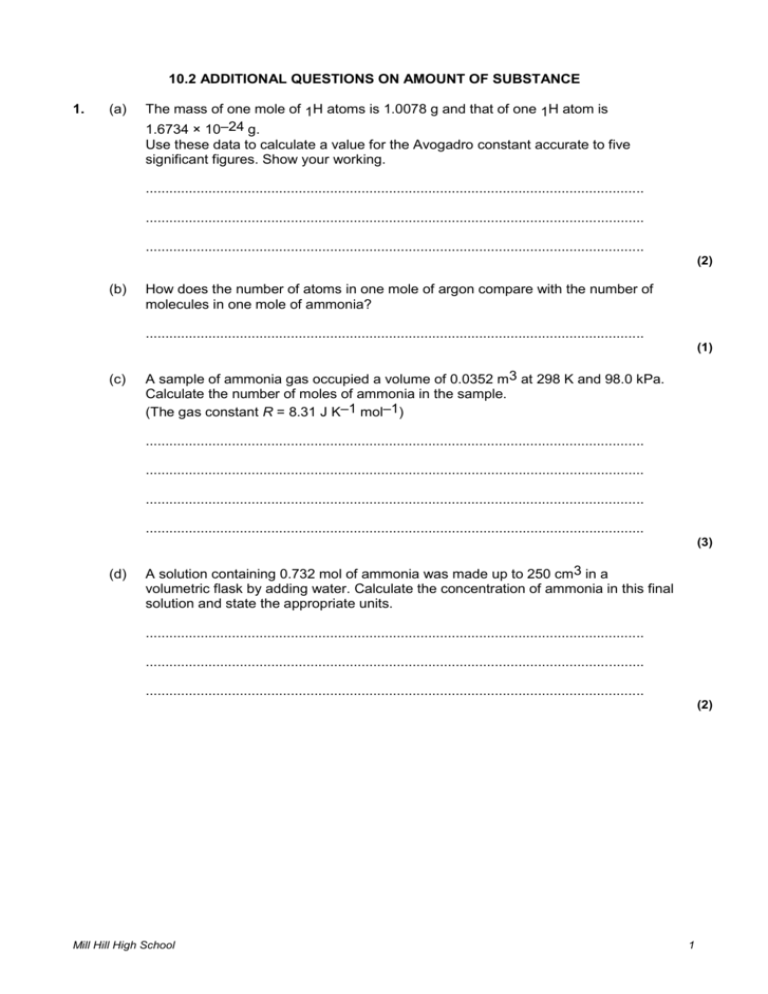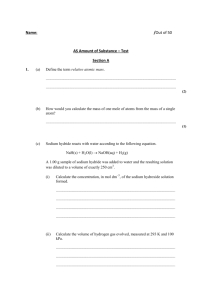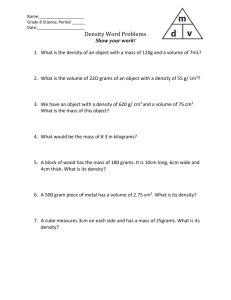Amount of Substance Chemistry Worksheet
advertisement

10.2 ADDITIONAL QUESTIONS ON AMOUNT OF SUBSTANCE 1. (a) The mass of one mole of 1H atoms is 1.0078 g and that of one 1H atom is 1.6734 × 10–24 g. Use these data to calculate a value for the Avogadro constant accurate to five significant figures. Show your working. ............................................................................................................................... ............................................................................................................................... ............................................................................................................................... (2) (b) How does the number of atoms in one mole of argon compare with the number of molecules in one mole of ammonia? ............................................................................................................................... (1) (c) A sample of ammonia gas occupied a volume of 0.0352 m3 at 298 K and 98.0 kPa. Calculate the number of moles of ammonia in the sample. (The gas constant R = 8.31 J K–1 mol–1) ............................................................................................................................... ............................................................................................................................... ............................................................................................................................... ............................................................................................................................... (3) (d) A solution containing 0.732 mol of ammonia was made up to 250 cm3 in a volumetric flask by adding water. Calculate the concentration of ammonia in this final solution and state the appropriate units. ............................................................................................................................... ............................................................................................................................... ............................................................................................................................... (2) Mill Hill High School 1 (e) A different solution of ammonia was reacted with sulphuric acid as shown in the equation below. 2NH3(aq) + H2SO4(aq) 4)2SO4(aq) In a titration, 25.0 cm3 of a 1.24 mol dm–3 solution of sulphuric acid required 30.8 cm3 of this ammonia solution for complete reaction. (i) Calculate the concentration of ammonia in this solution. ...................................................................................................................... ...................................................................................................................... ...................................................................................................................... ...................................................................................................................... (ii) Calculate the mass of ammonium sulphate in the solution at the end of this titration. ...................................................................................................................... ...................................................................................................................... ...................................................................................................................... ...................................................................................................................... (6) (f) The reaction of magnesium nitride, Mg3N2, with water produces ammonia and magnesium hydroxide. Write an equation for this reaction. ................................................................................................................................ (2) (Total 16 marks) Mill Hill High School 2 2. (a) A 2.05 g sample of a gaseous hydrogen halide was found to occupy a volume of 1250 cm3 at a pressure of 50.6 kPa and a temperature of 300 K. Use the ideal gas equation to help you to identify this hydrogen halide. ...................................................................................................................... ...................................................................................................................... ...................................................................................................................... ...................................................................................................................... ....................................................................................................................... ...................................................................................................................... (5) (b) Calculate the maximum mass of sodium sulphide that can be obtained from 10.0 g of sulphur. (2) (c) Calculate the minimum volume of hydrogen, in cm3, at 298 K and 101.3 kPa, that is needed to form 5.00 g of hydrogen sulphide. molar gas volume = 24.5 dm3 mol–1 at 298 K and 101.3 kPa (3) (c) A manufacturer buys 1000 tonnes of pure sulphur. Assuming a 95% conversion to sulphuric acid, calculate the mass of sulphuric acid obtainable from this quantity of sulphur. ...................................................................................................................... ...................................................................................................................... ...................................................................................................................... ...................................................................................................................... (3) (Total 13 marks) Mill Hill High School 3 3. (a) bromine. D contains 35.0% carbon and 6.57% hydrogen by mass, the remainder being Calculate the empirical formula of D. ............................................................................................................................ ............................................................................................................................ ............................................................................................................................ ............................................................................................................................ ............................................................................................................................ (4) (b) What experimental data are required in order to calculate the empirical formula of a compound? ..................................................................................................................................... ..................................................................................................................................... (1) (c) Barium nitrate decomposes on heating as follows: Ba(NO3)2(s) (i) BaO(s) + 2NO2(g) + ½ O2(g) Calculate the total volume, measured at 298 K and 100 kPa, of gas which is produced by decomposing 5.00 g of barium nitrate. ............................................................................................................................ ............................................................................................................................ ............................................................................................................................ ............................................................................................................................ ............................................................................................................................ (ii) Calculate the volume of 1.20 M hydrochloric acid which is required to neutralise exactly the barium oxide formed by decomposition of 5.00 g of barium nitrate. Barium oxide reacts with hydrochloric acid as follows Cl2(aq) + H2O(l) ............................................................................................................................ ............................................................................................................................ ............................................................................................................................ (7) (Total 12 marks) Mill Hill High School 4 4. (a) Give the meaning of the term “mole” as used in the phrase “one mole of molecules”. ............................................................................................................................ ............................................................................................................................ ............................................................................................................................ (1) (b) The mass of one atom of C is 1.99 x 10 g. Use this information to calculate a value for the Avogadro constant. Show your working. ............................................................................................................................ ............................................................................................................................ ............................................................................................................................ (2) (c) A manufacturer plans to use xenon in a lamp of volume 4.60 cm3. What mass of xenon will be needed to give a pressure of 7.50 × 105 Pa when the average temperature of the lamp has reached 1200 °C? (R = 8.314 J K–1 mol–1) ............................................................................................................................ ............................................................................................................................ ............................................................................................................................ ............................................................................................................................ ............................................................................................................................ (4) (d) Analysis of the tungsten iodide formed in a lamp showed that it contained 42.0 % by mass of tungsten (symbol W). Calculate the empirical formula of the tungsten iodide. ........................................................................................................................... ............................................................................................................................ ............................................................................................................................ ............................................................................................................................ ............................................................................................................................ (3) Mill Hill High School 5 (c) Ethanol vapour is kept at a pressure of 1.01 × 105 Pa and a temperature of 93 °C. State the ideal gas equation and use it to calculate the volume, in cm3, that 1.36 g of ethanol vapour would occupy under these conditions.(R = 8.314J K–1 mol–1) Ideal gas equation ...................................................................................................... Calculation (5) (Total 15 marks) 5. (a) The process of “blueprinting” involves the production of an insoluble blue pigment, known as Prussian Blue, by the reaction of iron(II) ions with potassium hexacyanoferrate(III). Deduce a possible formula for Prussian Blue, given that analysis of the blue pigment shows that it contains 22.15% carbon, 34.46% iron, 25.85% nitrogen, 12.00% potassium and 5.54% water by mass. ............................................................................................................................ ............................................................................................................................ ............................................................................................................................ ............................................................................................................................ ............................................................................................................................ (4) Mill Hill High School 6 (b) A factory storage tank of capacity 3.50 m3 contains 30.0 kg of propane gas (C3H8) under pressure. The temperature inside the tank is 22.0 °C. (R = 8.314 J K–1 mol–1) (i) State the expression that could be used to calculate the pressure inside the tank. ........................................................................................................................... (1) (ii) Use the values given above to calculate the pressure inside the tank. (4) (Total 9 marks) 6. Ammonium nitrate can be prepared by the reaction between ammonia and nitric acid. NH3 + HNO3 (a) → NH4NO3 The concentration of a nitric acid solution is 2.00 moldm-3. Calculate the volume of this solution which would be required to react with exactly 20.0 g of ammonia …………………………………………………………………………………………………… …………………………………………………………………………………………………… …………………………………………………………………………………………………… (4) (b) A sample of ammonium nitrate decomposes on heating as shown in the equation below. NH4NO3 → 2H2O + N2 + ½ O2 On cooling the resulting gases to 298 K, the volume of nitrogen and oxygen was found to be 0.0500 m3 at pressure of 95.0 kPa. Mill Hill High School 7 (i) State the ideal gas equation and use it to calculate the total number of moles of nitrogen and oxygen formed. (R= 8.31 J mol-1K-1) ……………………………………………………………………………………………………… ……………………………………………………………………………………………………… ……………………………………………………………………………………………………. (3) (ii) Using your answer to part (b)(i), deduce the number of moles of ammonium nitrate decomposed and hence calculate the mass of ammonium nitrate in the sample Moles of ammonium nitrate ……………………………………………… Mass of ammonium nitrate ………………………………………………. ……………………………………………………………………………. (3) TOTAL 10 marks 7. (a) Titanium (IV) chloride reacted with water as shown in the following equation TiCl4 (l) + 2H2O (l) → 4HCl (aq) + TiO2 (s) The reaction produced 200 cm3 of a 1.20 M solution of hydrochloric acid. Calculate the number of moles of HCl in the solution and use your answer to find the original mass of TiCl4 Moles of HCl ……………………………………………………………………. ……………………………………………………………………………………. Mass of TiCl4 …………………………………………………………………… ..…………………………………………………………………………………………… …………………………………………………………………………………………… (4) Mill Hill High School 8 (b) Calculate the volume of 1.10 M sodium hydroxide solution which would be required to neutralise a 100 cm3 portion of 1.20 M solution of hydrochloric acid ……………………………………………………………………………………………………………………………………………………… ………………………………………………………………………………………………………………………………………………………. (3) (c) An excess of magnesium metal was added to 100 cm3 portion of the 1.20 M solution of hydrochloric acid. Calculate the volume of hydrogen gas produced at 98 kPa and 20oC. → Mg (s) + 2HCl (aq) MgCl2 (aq) + H2 (g) …………………………………………………………………………………………………… …………………………………………………………………………………………………… …………………………………………………………………………………………………… ……………………………………………………………………………………………………. (4) TOTAL 11 marks 8. (a) (i) 100 cm3 of a standard solution of Na2CO3 was produced by dissolving 0.537 g of Na2CO3 in water in a volumetric flask. On titration 25.00 cm3 of the Na2CO3 (aq) solution required 23.75 cm3 of hydrochloric acid for complete neutralisation. Calculate the concentration in moldm-3 of hydrochloric acid. Na2CO3 (aq) + 2HCl (aq) → 2NaCl (aq) + H2O (l) + CO2 (g) (3) (ii) Calculate the mass in grams of HCl in 560 cm3 of hydrochloric acid of concentration 0.145 moldm-3 (2) Mill Hill High School 9 (b) The equation below represents the thermal decomposition of KClO3. 2KClO3 (s) → (i) 2KCl (s) + 3O2 (g) Calculate the mass of oxygen which could be produced by the complete decomposition of 1.47 g of KClO3. (2) (ii) Calculate the mass of KClO3 required to produce 1.00 dm3 at 20oC and 101.3 kPa of oxygen. (3) (c) 200 cm3 of an aqueous solution of hydrogen chloride was prepared. During titration a 25.0 cm3 portion of this required 27.60 cm3 of aqueous sodium hydroxide of concentration 0.100 moldm-3, for complete neutralisation. (i) Calculate the number of moles of sodium hydroxide in 27.60 cm3 of aqueous sodium hydroxide solution. (1) (ii) State the number of moles of acid neutralised in the reaction. (1) Mill Hill High School 10 (iii) Calculate the number of moles of acid in the original 200 cm 3 solution of the acid. (1) (iv) Calculate the concentration of the acid in moldm-3. (1) TOTAL 14 marks 9. (a) Compound A (Mr = 215.8) contains 22.24 % carbon, 3.71 % hydrogen and 74.05 % bromine by mass. Show that the molecular formula of A is C4H8Br2 (3) (b) (i) A naturally occurring compound of calcium contains by mass 23.29 % of calcium, 18.64 % of sulphur and 2.32 % of hydrogen, the remainder being oxygen Determine the empirical formula of this compound. (ii) For any compound, what is the relationship between empirical and molecular formula? What additional information is required to determine a molecular formula from an empirical formula? (5) TOTAL 8 marks Mill Hill High School 11






